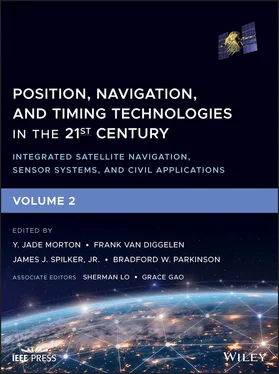35.1.1 What Is a Navigation Sensor?
The physical sensor, depicted as the yellow block in Figure 35.1, is a critical part of any navigation system, and selection of the right sensor or combination of sensors is one of the most important decisions a navigation system designer can make. What comprises a navigation sensor?
At a basic level, any physical sensor that measures something which changes when the sensor is moved is a potential navigation sensor. Additionally, since clocks are an integral part of many navigation systems, we also consider clocks in this section as well. In contrast to a navigation sensor, which measures something that changes when the sensor is moved in some way, a clock is a sensor that measures how time “moves.” A summary of the major sensors covered in Volume 2 is given in Table 35.1.
Table 35.1 Sensors covered in Volume 2
| Sensor |
Sensed phenomenon |
World model required |
Other considerations |
| Cellular RF receiver |
Cellular phone RF signals |
Positions of cell towers, signal timing |
Example of signal of opportunity (SoOP), reference receiver sometimes required |
| Terrestrial beacon receiver |
Navigation signals from terrestrial beacons |
Beacon locations, signal structure, signal timing |
Requires dedicated infrastructure, more design flexibility than SoOP |
| Digital TV receiver |
Digital TV signals |
Transmitter locations, signal timing |
Example of SoOP, reference receiver sometimes required |
| Low‐frequency receiver |
Low‐frequency RF signals |
Transmitter location or direction of arrival, local distortion effects |
Susceptible to local distortions, generally less accurate than higher frequency/wider bandwidth signals |
| Radar |
RF signals |
Locations of identifiable RF reflectors for absolute positioning |
Generally larger/higher power than receiver‐based systems |
| Low‐Earth orbit (LEO) satellite receiver |
Signals from LEO satellites |
LEO satellite position/velocity, signal timing (in some cases), atmospheric models |
Greater geometric/signal diversity and higher received power than GNSS |
| Inertial |
Rotation and specific force |
Gravitational field |
Dead‐reckoning only – drift normally requires update |
| GNSS |
RF signals from satellites |
Satellite ephemeris and clock errors, atmospheric models |
Ideal for updating inertial |
| Magnetometer |
Magnetic field (including variations) |
Magnetic field map |
Local (vehicle) effects calibration may be required |
| LiDAR |
Range and intensity of laser returns |
Shape/location of objects being sensed |
Can be used in dead‐reckoning or absolute modes |
| Cameras |
Intensity of light as a function of direction |
Map of image features or three‐dimensional image model for absolute positioning |
Can be used in dead‐reckoning or absolute modes |
| X‐ray detector |
X‐ray signals coming from pulsars |
Knowledge of pulsar directions and signal characteristics (including timing) |
Positioning is based on signal time of arrival |
| Clock |
Varies by clock type |
Perhaps calibration parameters |
Measures rate of time passage (frequency), and if initialized and integrated, absolute time |
35.2 Summary of Content of Volume 2
Volume 2 begins with an overview of nonlinear estimation techniques ( Chapter 36), which are often required when integrating complementary navigation sensors. This chapter also lays the groundwork for the estimation strategies that are described in subsequent chapters.
The next group of chapters covers a variety of RF‐based complementary navigation techniques. Many of the principles and algorithmic approaches for indoor navigation are summarized in Chapter 37, as well as a survey of different types of indoor navigation sensors and phenomenologies. This is followed by several chapters which describe in detail a variety of RF signals, including cellular ( Chapter 38), terrestrial navigation beacons ( Chapter 39), digital television ( Chapter 40), low‐frequency systems ( Chapter 41), radar ( Chapter 42), and RF signals from low‐Earth orbiting (LEO) satellites ( Chapter 43).
There are two chapters that describe inertial technology : a general introduction to INS ( Chapter 44) and MEMS inertial systems ( Chapter 45). The introduction chapter provides an overview of inertial systems. It describes the fundamental mechanisms of various accelerometers and gyroscopes that are the building blocks of INS, their error characteristics and performances, and outlook of technology advancement. The focus of MEMS inertial sensors is to reduce the cost, size, weight, and power when compared to existing inertial sensors. Doing so would expand the applications in which it is feasible to leverage inertial technology.
It is important to recognize that inertial systems cannot operate without aiding from additional sensors, other than for short time periods. The primary reason for this is that inertial systems are unstable in the vertical channel, so at a minimum they need some sort of aiding of the vertical channel (such as a barometric altimeter or terrain height aiding). Even if the vertical channel is aided, the horizontal directions will drift in an inertial system, with the rate of drift determined by the quality of the system and the accuracy of the initialization of the attitude and position of the system. (Even if an INS had perfect gyroscopes and accelerometers, there would still be growing error due to imperfections in our knowledge of gravity).
Probably the most common sensor used to aid an inertial is a GNSS receiver . Chapter 46describes classic approaches for integrating GPS with INS, including loose and tight integration. It also describes a different way of thinking about the GPS/INS integration problem, in which there is more emphasis on using carrier‐phase measurements to provide velocity‐like updates to the INS, with additional correction from the pseudorange measurements.
Clock has been an essential sensor for navigation since ancient times. The accuracy and stability of clocks continue the improve in recent decades. Chapter 47provides an overview of recent technology development in atomic clocks for GNSS.
An approach for using knowledge of the variation in Earth’s magnetic field for absolute positioning using a magnetometer is described in Chapter 48. This method works indoors, on a ground vehicle, and in an aircraft, and this chapter describes the differences between these different environments and shows examples of working systems in each case.
Next, the use of LiDAR for navigation is described in Chapter 49. Various types of LiDARs are considered, as well as different ways in which LiDAR data can be leveraged for navigation purposes. This chapter also describes features that can be identified using LiDAR data, and how those features can be incorporated into an integrated navigation system. Both dead‐reckoning and absolute positioning/attitude approaches are considered.
Chapter 50describes the many ways in which cameras can be used for navigation. Initially, a mathematical model of a camera is provided, as well as methods for camera calibration. Image features are described as well as algorithms for using these features to relate camera images to position and rotation of the camera. Several methods for image navigation are described, and as with LiDAR, both dead‐reckoning and absolute positioning/attitude approaches are considered. Another chapter (51) is dedicated to the topic of photogrammetry, which also uses a camera, but lays more emphasis on using the camera in order to develop knowledge about the scene that is viewed by one or more cameras. The vision navigation and photogrammetry chapters can be thought of as opposite sides of the same coin. With vision navigation, the desire is to figure out where the camera is, based on some knowledge of the scene. With photogrammetry, the desire is to figure out information about the scene, based on some knowledge of the camera position (and perhaps orientation).
Читать дальше











